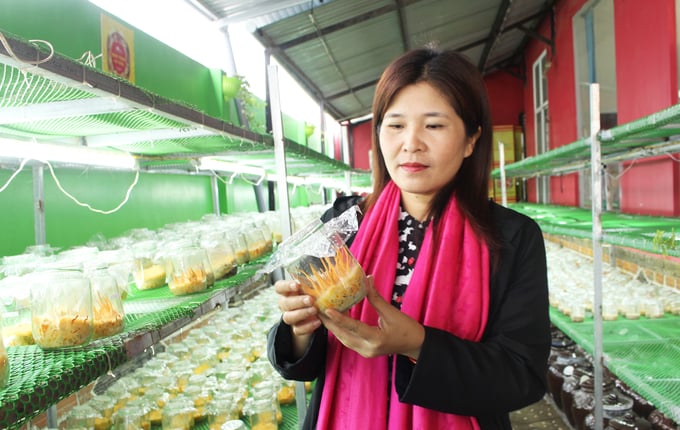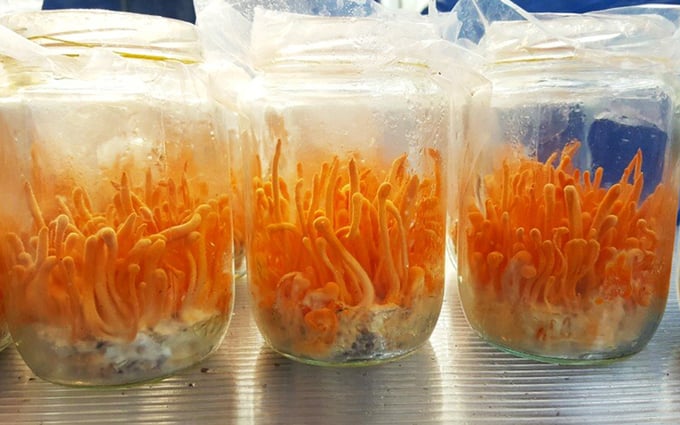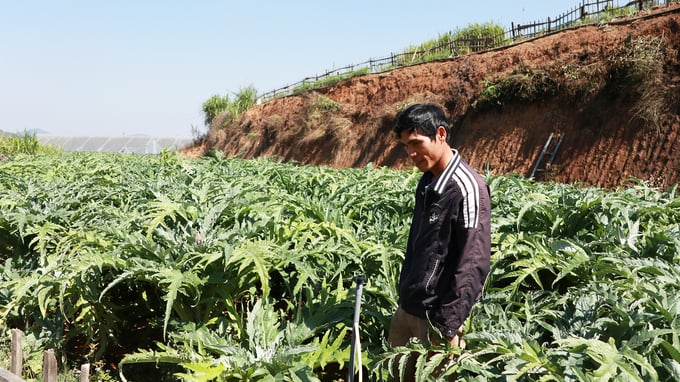June 21, 2025 | 01:37 GMT +7
June 21, 2025 | 01:37 GMT +7
Hotline: 0913.378.918
June 21, 2025 | 01:37 GMT +7
Hotline: 0913.378.918
According to Lam Dong Department of Agriculture and Rural Development, the province has many advantages in terms of natural conditions for the development of medicinal plants. The production of medicinal plants in the province has continuously increased in both area and output over the past few years.
Reports show that Lam Dong had 150 hectares of medicinal plants in 2015. This figure rose to 410 hectares by 2019 and 548 hectares by 2022. The total output of medicinal plants is currently estimated at around 10 thousand tons.

Production model of cordyceps in Lam Dong. Photo: Minh Hau.
The production model of medicinal plants is deployed on agricultural land and planted under the forest canopy in all 12 districts and cities within Lam Dong province. Namely, Da Lat city and Lac Duong district focus mainly on artichoke; Lam Ha, Don Duong, Duc Trong and Dam Rong districts focus on dong quai; Cat Tien and Di Linh districts focus on Ha Chau eucalyptus. Other medicinal plants such as reishi mushroom, cordyceps, ginseng, dandelion, false ginseng, yellow flower tea, Huperzia serrata, etc. are produced by farmers in all districts and cities across the province.
Lam Dong is divided into 3 climate zones including: below 500m altitude, 500 to 1,000m altitude and over 1,000m altitude. These regions are suitable for the production of different medicinal plant varieties, thereby increasing the richness and diversity of local products. Additionally, Lam Dong forest resources are incredibly rich with 513 thousand hectares of forested land, so the province has potential in developing medicinal plants under the forest canopy.
According to Lam Dong Department of Agriculture and Rural Development, the local agricultural sector has been studying and implementing a model of intercropping natural medicinal plants under the forest canopy. These plants include Panax sp. ginseng distributed in the forests of the mountainous Dam Rong district; Ha Thu O in Don Duong and Duc Trong districts; Tam Tam in Da Lat city and Lac Duong district; Sargentodoxa cuneata in Cat Tien district and Cibotium barometz in Bidoup - Nui Ba National Park. Medicinal plants such as areca ginseng, yellow flower tea, vine tea, black turmeric, amomum are all considered to be suitable for intercropping under the forest canopy.

Cordyceps production model generates an annual profit of 810 million VND/hectare. Photo: Minh Hau.
Mr. Nguyen Van Dien, an officer of Lam Dong Agricultural Extension Center, said that there are currently nearly local 60 businesses and cooperatives organizing the purchase and processing of medicinal plant products. Regarding the consumption market, at least 80% of the local medicinal products are consumed domestically, the remaining 20% are exported to Japan, Korea, Laos, Netherlands, USA, Germany, France among many other international markets.
The production of medicinal plants such as artichoke, ginseng, dong quai, and Phyllanthus urinaria has higher economic value compared to that of traditional agricultural plants. According to the agricultural sector of Lam Dong province, artichoke production generates an annual profit of nearly 600 million VND/hectare; Ganoderma lucidum production generates an annual profit of 665 million VND/hectare; cordyceps production generate an annual profit of 810 million VND/hectare; ginseng production generate an annual profit of 330 million VND/ha/year.
In order to further utilize its potentials, enhance values and develop sustainably, Lam Dong province is implementing the project of developing production and processing areas in association with medicinal plants consumption from 2020 to 2025.

Lam Dong province has set the goal of reaching a over 18 thousand tons of medicinal plants in terms of output by 2025. Photo: Minh Hau.
Accordingly, Lam Dong focuses on developing strong varieties such as artichokes, lingzhi, dong quai, ginseng as well as expanding the area of medicinal plants to reach 718 hectares by 2025. Namely, 230,4 hectares will be dedicated to intercropped medicinal plants on agricultural land, 293 hectares for pure medicinal plants on agricultural land and 194.5 hectares for medicinal plants planted under forest canopy. Lam Dong province also set the goal of reaching a over 18 thousand tons of medicinal plants in terms of output by 2025.
According to Lam Dong Department of Agriculture and Rural Development, the project also sets out the goal of developing a variety of medicinal plants toput into production, with emphasis on varieties with high economic value. On the other hand, the project aims to improve the production capacity and increase the average production value of medicinal plants to 450 million VND/hectare/year. Locally processed medicinal products is expected to reach 30% by 2025.
Mr. Nguyen Van Dien said that the project focuses on developing the area of medicinal plants on a large scale. Namely, the project supports 70 models with a total area of 18 hectares that apply high technology and exploit medicinal herbs in the direction of GAP in association with processing. These models are expected to develop new medicinal species with high economic value and stable consumption markets.
The model of growing artichokes, ginseng, lingzhi, dong quai in addition to newly imported varieties for processing will be deployed in Da Lat city and the districts of Lac Duong, Don Duong, Dam Rong, Lam Ha, Duc Trong, etc.
In addition to the development of raw material areas, the agricultural sector of Lam Dong province also builds production linkages in association with processing and consumption. Factories, pre-processing and processing facilities will be specialized to improve product value.
Lack of concentrated seed production facilities
According to Lam Dong Department of Agriculture and Rural Development, there is currently no concentrated production and trading facility for medicinal seeds in the province. The production of new medicinal plant varieties is seasonal and dependent on orders. The province also does not have a high-tech production facility for medicinal herbs. Lam Dong has not developed and published basic standards for the quality of medicinal plant varieties. The current propagation methods for medicinal plant have not been thoroughly evaluated; they are not developed into a specific process, and the varieties are not controlled before being supplied to the consumers.
Some medicinal plant seeds must be imported or migrated from other provinces for production, such as dong quoi, ginseng, etc.
Translated by Nguyen Hai Long
![Turning wind and rain into action: [9] Digitizing hydrometeorological data in response to climate change](https://t.ex-cdn.com/nongnghiepmoitruong.vn/608w/files/news/2025/06/17/z6704423696987_15fd32ffc26d590d204d520c9dac6786-nongnghiep-165943.jpg)
(VAN) Farmers have begun accessing hydrometeorological applications to adjust their cropping schedules, aiming to ensure productivity and adapt to climate change.
![Turning wind and rain into action: [8] Real-time salinity detection and early warning technology](https://t.ex-cdn.com/nongnghiepmoitruong.vn/608w/files/news/2025/06/17/z6704423696987_15fd32ffc26d590d204d520c9dac6786-nongnghiep-151127.jpg)
(VAN) Thanks to the integration of modern hydrological-hydraulic models, remote sensing technologies, and artificial intelligence, the accuracy of hydrological forecasting has significantly improved.
![Turning wind and rain into action: [7] Early disaster warnings help marine farmers minimize losses](https://t.ex-cdn.com/nongnghiepmoitruong.vn/608w/files/news/2025/06/17/z6704423696987_15fd32ffc26d590d204d520c9dac6786-nongnghiep-142942.jpg)
(VAN) In recent years, thanks to early disaster warnings and forecasting, marine farmers in Khanh Hoa province have been able to reduce risks and losses, thereby improving production efficiency.
![Turning wind and rain into action: [6] ‘Four on-the-spot’ disaster management software](https://t.ex-cdn.com/nongnghiepmoitruong.vn/608w/files/news/2025/06/17/e5a48259d6a262fc3bb3-nongnghiep-183800.jpg)
(VAN) By simply activating the scenario on the disaster management software, the relevant authorities immediately know how many households need to be evacuated, where to evacuate them to, and by what means of transportation…
![Turning wind and rain into action: [5] Hue applies modern technology in disaster forecasting](https://t.ex-cdn.com/nongnghiepmoitruong.vn/608w/files/news/2025/06/17/z6704423696987_15fd32ffc26d590d204d520c9dac6786-nongnghiep-093938.jpg)
(VAN) In Hue city, modern technology has recently been applied in meteorological and hydrological forecasting and warning, helping to reduce the damage caused by natural disasters.

(VAN) A cutting-edge farming technique being implemented on an experimental ranch in Arizona's Sonoran Desert has already saved a billion gallons of water over five years, according to Civil Eats.

(VAN) Poultry and pig production and the environment can be boosted through enhanced water technology, according to new research.